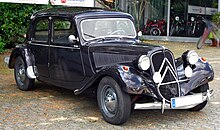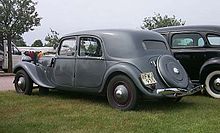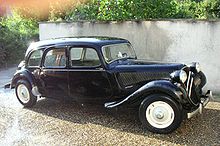Citroën Traction Avant
| Citroën | |
|---|---|
|
Citroën Traction Avant, 1954
|
|
| Traction Avant | |
| Production period: | 1934-1957 |
| Class : | upper middle class |
| Body versions : | Sedan , station wagon , coupé , convertible |
| Engines: |
Petrol engines : 1.3–2.9 liters (23.5–57 kW) |
| Length: | 4650 mm |
| Width: | 1790 mm |
| Height: | 1540 mm |
| Wheelbase : | 3090 mm |
| Empty weight : | 1025-1170 kg |
| Previous model | Citroën Rosalie |
| successor | Citroën DS |
Traction Avant (German for “ front-wheel drive ”) is the common name for the first front-wheel drive Citroën series models 7A, 7B, 7C, 11B (with in-line four- cylinder engines ) and 15/6 (with in-line six-cylinder engines ), which were built between 1934 and 1957.
history
The Traction Avant was developed under the direction of André Lefèbvre and Flaminio Bertoni , who were also responsible for the successor, the Citroën DS , in 1955 . Jean Daninos , who founded Facel- Metallwerke in 1939 and later the serial body construction company Facel-Métallon , was involved in the development of the vehicle . From the latter, the car brand Facel Vega emerged.
technology

The Citroën Traction Avant had many technical features that were novel at the time and are standard in today's automotive engineering. The TA is one of the first cars with self-supporting bodies . This made them lighter and had a lower center of gravity than the competition. By installing the engine behind and the gearbox in front of the front axle, a good load distribution was achieved. The top speed of the vehicle was 130 km / h. With the driven front wheels, which were individually suspended from double wishbones and torsion bar springs , and the rigid rear axle, which was guided on two trailing arms with torsion bar springs and a Panhard bar , excellent road holding and excellent comfort were achieved for the time . One of Citroën's slogans was: La Traction Avant dompte la force centrifuge , translated: The Traction Avant tames centrifugal forces.
1934 some 22 CV with were at the Paris and Brussels Motor Show eight-cylinder - V engine , 3.82 liters of displacement and 100 hp presented. These cars had headlights embedded in the fenders. The first vehicles were equipped with a Ford engine because their own engine was not yet ready for series production. A total of around 20 vehicles of this type are said to have been built. About the whereabouts of these vehicles it is said that they were converted into 11 CV and the special front parts were destroyed without exception.
Other technical features

In all “Traction Avant” models, the gearbox is located in front of the engine, which is mounted in silent blocks . The four gears (three forward and one reverse gear) are selected using a gearshift lever in the dashboard, so no revolver gearshift as in contemporary DKW and Adler or later in 2 CV and Renault 4. The carburetor engines with overhead valves have a camshaft located below, which via a Timing chain is driven. The ignition distributor contains a centrifugal adjuster to adapt the ignition point to the engine speed.
The 7 CV has a capacity of 1303 cm³ and develops 46 hp (34 kW) at 3800 rpm; the 11 CV has 1911 cm³ and develops around 56 hp (41 kW) at the same speed. The consumption of the 11 CV is around 12 l per 100 km. The 15 CV with its 2.9-liter six-cylinder engine achieves just under 78 hp (57 kW). Speeds of 140 to 145 km / h are quite possible. The body of the 15 CV differs only slightly from that of the 11 CV B (normal); it is the same except for the front section 11 cm longer on the 15 CV; The bodies of the 11 CV BL (Légère) and the 7 CV are similar.
The front doors of the cars are hinged at the back (so-called suicide doors ), so that easy entry and exit is guaranteed.
The front window of the car can be easily opened at the bottom, so the interior can be ventilated in warmer weather. For operation in cold regions or in winter, a blind can be installed in front of the radiator grille so that the engine reaches its operating temperature more quickly.
technical changes
- From 1936 onwards, all models were given a rack and pinion steering system that was more precise than the roller steering system that was used up until then .
- From 1947 a new gearbox was installed in the 15 CV, the engine was now clockwise.
- The six-window body was built from 1954.
In 1953, serious rumors about the imminent introduction of an ultra-modern successor led to a noticeable drop in sales for the now almost twenty-year-old construction. Therefore, from 1954 onwards, the 15 CV could be ordered with a hydropneumatically sprung rear axle ( hydropneumatics ). The model name was then 15 / 6H.
Model variants
The Traction Avant was available in different body shapes and sizes:
- short and narrow: 7C, 11BL (Légère) as sedan , convertible and faux convertible (= coupé )
- medium long and wide: 11BN (normal) (sedan, convertible and faux convertible) and 15/6 (sedan and some convertibles)
- long and wide (Large): 11BF and 11BC and 15 / 6F and 15 / 6C Familiale and Commerciale (the latter with tailgate), each with three rows of seats and three windows on each side.
After the Second World War , the hoods with side flaps were replaced by those with side slits. In 1952 there was the only major change in the design: the bumpers were straightened, the trunk lid with an external cover for the spare wheel ("wheel model") was replaced by a more curved flap that created a significantly larger trunk with an internal spare wheel ("case model"). ) released. Furthermore, the windshield wipers previously mounted above were positioned below the windshield.
The cabriolet was no longer manufactured after 1945.
Surname
Often you can find the abbreviations Traction or simply TA . A “Traction Avant” (“front-wheel drive”) was such a huge technical innovation in series automobile production in 1934 that this term has been used to describe this type of vehicle ever since. The play on words l'attraction (French for: the attraction ) is often used instead of la traction (French for: the drive ). It was also known as the "gangster limousine", which was due to its excellent road holding, because according to legend, it was the ideal escape vehicle of its time.
The vehicle is also known as 11 CV or 15 CV. CV is the name for the category of the French vehicle tax calculation. This designation was used by some manufacturers as a type designation at that time. It is often confused with the engine power ch ( French Cheval-vapeur = " horse power ").
Exactly 1823 models of the 7A, 7B and 7C series were assembled between 1934 and 1935 in the German Citroën production plant in Cologne-Poll . Due to its Cologne origin, the TA was sometimes called the bollard in Germany .
literature
- Immo Mikloweit: Citroën. Passenger car since 1919 . 1st edition. Motorbuch, Stuttgart 2000. ISBN 3-613-02041-6
Web links
Individual evidence
- ^ Citroën automobile production plant in Poll . In: KuLaDig, Kultur.Landschaft.Digital. (accessed January 10, 2019)








